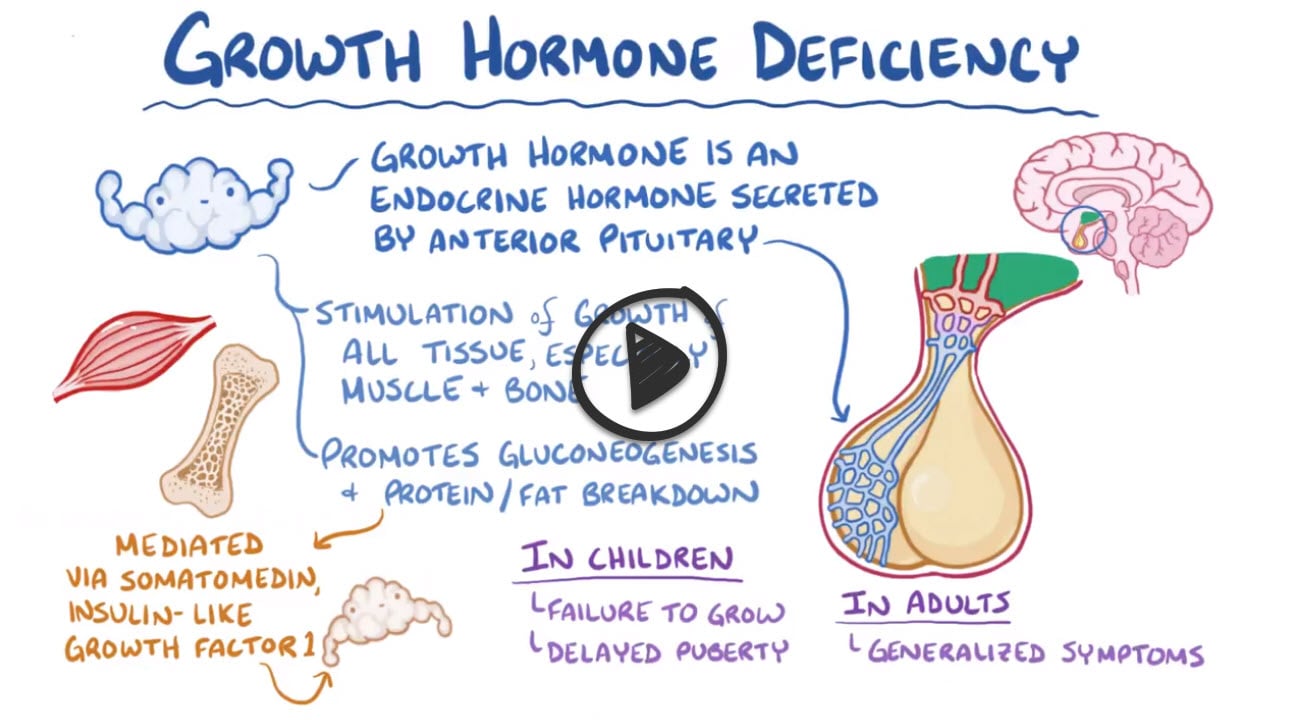Patient will present as → a 3-year-old male who is brought to your office by his mother, who is concerned that he is not growing appropriately. Physical examination is notable for frontal bossing and shortened upper and lower extremities. His axial skeleton appears normal. He is at the fourth percentile for height and 95th percentile for head circumference. He demonstrates normal intelligence and can speak in three-word sentences. He first sat up without support at twelve months and started walking at 24 months. Labs reveal decreased GH and decreased IGF-1.
Pituitary dwarfism, or growth hormone deficiency, is a condition in which the pituitary gland does not make enough growth hormone. This results in a child's slow growth pattern and unusually small stature (below average height)
- Growth hormone secretion can be decreased in adults, resulting in lower bone density and decreased muscle mass, but this will not affect bone growth
- The primary manifestations of growth hormone deficiency in infancy are hypoglycemia and micropenis
- In children, bone growth is typically delayed relative to chronological age due to an under-stimulation of osteoblasts which can result in short stature
Growth hormone (GH) deficiency can occur in isolation or in association with generalized hypopituitarism
- Causes include congenital (including genetic) disorders and several acquired disorders of the hypothalamus and/or pituitary
Serial measurements > 2.5 deviations below the normal mean should prompt growth hormone evaluation
- Diagnosis can be confirmed by low levels of insulin-like growth factor-1 and insulin-like growth factor binding protein-3
- Labs: ↓ GH, ↓ IGF 1
BONE AGE: The primary symptom of pituitary dwarfism is a lack of height. Therefore, a change in the individual's growth habits will help lead to a diagnosis. X-ray the child's hand to determine the child's bone age by comparing this to the child's actual chronological age.
- The bone age in affected children is usually two years or more behind the chronological age. This means that if a child is ten years old, his or her bones will look like they are those of an eight-year-old child. The levels of growth hormone and somatomedin C must also be measured with blood tests.
CT or MRI of the brain to evaluate for cause
Growth hormone deficiency can be treated with subcutaneous injections of recombinant human growth hormone to try and stimulate normal growth
- Surgery may be necessary to remove a pituitary adenoma if that is the cause of dwarfism
- Other manifestations of hypopituitarism are treated as needed
- Complications: Poorly developed organs including the heart, impaired sexual maturation, kyphosis, arthritis, sleep apnea, spinal stenosis, motor delays, ear infections, hearing loss
Question 1 |
Familial short stature | |
Chromosomal abnormality Hint: While chromosomal abnormalities can cause short stature, they are less common and often associated with other clinical features or developmental delays, which are not present in this case. | |
Constitutional delay of growth and development Hint: This is a common cause of short stature and delayed puberty, but these children typically have a delayed growth spurt and are late bloomers, which doesn't align with the consistent growth pattern described. | |
Hypothyroidism Hint: Hypothyroidism can lead to growth retardation, but it typically presents with other symptoms such as fatigue, cold intolerance, and constipation. Additionally, growth velocity would likely be affected, which is not indicated in this scenario. | |
Growth hormone deficiency Hint: This condition results in short stature and decreased growth velocity. However, it is less common than familial short stature and would typically present with other signs or a more significant deviation from the expected growth curve. |
Question 2 |
Bone age is advanced in both familial short stature and constitutional delay of growth Hint: This statement is incorrect as bone age is typically normal in familial short stature and delayed in constitutional delay of growth. | |
Bone age is delayed in familial short stature and normal in constitutional delay of growth Hint: This is the opposite of the actual relationship; bone age is normal in familial short stature and delayed in constitutional delay of growth. | |
Bone age is normal in familial short stature and delayed in constitutional delay of growth | |
Bone age is delayed in both constitutional delay of growth and growth hormone deficiency Hint: While bone age is delayed in constitutional delay of growth, it is also typically delayed in growth hormone deficiency, not normal. | |
Bone age is advanced in constitutional delay of growth and delayed in hypothyroidism Hint: Bone age is actually delayed in constitutional delay of growth. In hypothyroidism, bone age is also typically delayed, not advanced. |
Question 3 |
Oral growth hormone supplementation Hint: Growth hormone is not effective orally as it is digested in the stomach and thus inactivated before it can be absorbed. | |
Subcutaneous recombinant growth hormone injections | |
High-dose corticosteroids Hint: Corticosteroids can actually inhibit growth and are not used in the treatment of growth hormone deficiency. | |
Thyroxine supplementation Hint: While thyroid hormone is important for growth and development, thyroxine supplementation alone is not a treatment for growth hormone deficiency unless the patient also has hypothyroidism. | |
Insulin-like growth factor-1 (IGF-1) therapy Hint: IGF-1 is a downstream effect of growth hormone action. Although it plays a role in growth, the primary treatment for GH deficiency is recombinant growth hormone, not IGF-1 therapy. |
|
List |
References: Merck Manual · UpToDate


 Osmosis
Osmosis